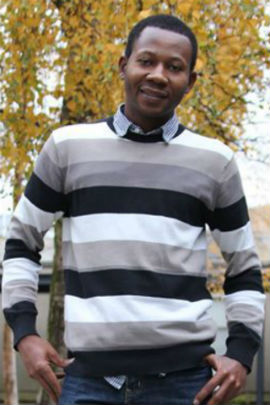Home > Press > Conducting gels -- from waste to wealth
 |
| Babatunde Okesola |
Abstract:
Research by scientists at the University of York has demonstrated an innovative way of using a gel to extract precious metals such as silver and gold from waste and convert them into conducting nanoparticles to form a hybrid nanomaterial potentially suitable for a range of high-tech applications.
Conducting gels -- from waste to wealth
York. UK | Posted on November 10th, 2015Discarded electronic devices are an ever-increasing waste stream containing high-value precious metals such as silver and gold. Making use of this resource was the inspiration for the research by a team from the Department of Chemistry at York.
Professor David Smith and Babatunde Okesola, a PhD student supported by The Wild Fund, discovered that their self-assembling gels derived from sorbitol, a simple sugar, could selectively extract precious metals from complex mixtures of other metals typical of the electronics or mining industries.
On exposure to the gel, not only were the precious metals selectively extracted, but they were also then converted into conducting nanoparticles via an in situ chemical reduction process, caused by the nanofibres of the gel network. These conducting nanoparticles become embedded in the gel giving it enhanced electrical conductance.
Fellow Department of Chemistry researchers, Dr Alison Parkin and Sindhu Suravaram, helped demonstrate the reduction mechanism which converts the metal ions into nanoparticles and explored the conducting nature of the resulting soft materials. The research is published in Angewandte Chemie.
Babatunde Okesola said: "Importantly, gels have properties of both solids and liquids so these conducting gels are potentially ideal to bridge between the soft, wet world of biology and the hard, dry world of electronics. Being able to 'wire up' this interface will be of increasing importance in future technologies."
Dr Smith added: "We hope to go on and test our gels using real-world electronic waste, and also explore the potential applications of the resulting materials at the interface between biology and electronics."
This will allow Professor Smith, Dr Parkin and their research teams to use the gels to convert waste into new soft materials capable of high-tech applications in their own right.
####
For more information, please click here
Contacts:
David Garner
44-019-043-22153
Copyright © University of York
If you have a comment, please Contact us.Issuers of news releases, not 7th Wave, Inc. or Nanotechnology Now, are solely responsible for the accuracy of the content.
| Related News Press |
News and information
![]() Researchers develop molecular qubits that communicate at telecom frequencies October 3rd, 2025
Researchers develop molecular qubits that communicate at telecom frequencies October 3rd, 2025
![]() Next-generation quantum communication October 3rd, 2025
Next-generation quantum communication October 3rd, 2025
![]() "Nanoreactor" cage uses visible light for catalytic and ultra-selective cross-cycloadditions October 3rd, 2025
"Nanoreactor" cage uses visible light for catalytic and ultra-selective cross-cycloadditions October 3rd, 2025
Discoveries
![]() Researchers develop molecular qubits that communicate at telecom frequencies October 3rd, 2025
Researchers develop molecular qubits that communicate at telecom frequencies October 3rd, 2025
![]() Next-generation quantum communication October 3rd, 2025
Next-generation quantum communication October 3rd, 2025
![]() "Nanoreactor" cage uses visible light for catalytic and ultra-selective cross-cycloadditions October 3rd, 2025
"Nanoreactor" cage uses visible light for catalytic and ultra-selective cross-cycloadditions October 3rd, 2025
Materials/Metamaterials/Magnetoresistance
![]() First real-time observation of two-dimensional melting process: Researchers at Mainz University unveil new insights into magnetic vortex structures August 8th, 2025
First real-time observation of two-dimensional melting process: Researchers at Mainz University unveil new insights into magnetic vortex structures August 8th, 2025
![]() Researchers unveil a groundbreaking clay-based solution to capture carbon dioxide and combat climate change June 6th, 2025
Researchers unveil a groundbreaking clay-based solution to capture carbon dioxide and combat climate change June 6th, 2025
![]() A 1960s idea inspires NBI researchers to study hitherto inaccessible quantum states June 6th, 2025
A 1960s idea inspires NBI researchers to study hitherto inaccessible quantum states June 6th, 2025
![]() Institute for Nanoscience hosts annual proposal planning meeting May 16th, 2025
Institute for Nanoscience hosts annual proposal planning meeting May 16th, 2025
Announcements
![]() Rice membrane extracts lithium from brines with greater speed, less waste October 3rd, 2025
Rice membrane extracts lithium from brines with greater speed, less waste October 3rd, 2025
![]() Researchers develop molecular qubits that communicate at telecom frequencies October 3rd, 2025
Researchers develop molecular qubits that communicate at telecom frequencies October 3rd, 2025
![]() Next-generation quantum communication October 3rd, 2025
Next-generation quantum communication October 3rd, 2025
![]() "Nanoreactor" cage uses visible light for catalytic and ultra-selective cross-cycloadditions October 3rd, 2025
"Nanoreactor" cage uses visible light for catalytic and ultra-selective cross-cycloadditions October 3rd, 2025
Interviews/Book Reviews/Essays/Reports/Podcasts/Journals/White papers/Posters
![]() Spinel-type sulfide semiconductors to operate the next-generation LEDs and solar cells For solar-cell absorbers and green-LED source October 3rd, 2025
Spinel-type sulfide semiconductors to operate the next-generation LEDs and solar cells For solar-cell absorbers and green-LED source October 3rd, 2025
![]() Rice membrane extracts lithium from brines with greater speed, less waste October 3rd, 2025
Rice membrane extracts lithium from brines with greater speed, less waste October 3rd, 2025
Environment
![]() Researchers unveil a groundbreaking clay-based solution to capture carbon dioxide and combat climate change June 6th, 2025
Researchers unveil a groundbreaking clay-based solution to capture carbon dioxide and combat climate change June 6th, 2025
![]() Onion-like nanoparticles found in aircraft exhaust May 14th, 2025
Onion-like nanoparticles found in aircraft exhaust May 14th, 2025
![]() SMART researchers pioneer first-of-its-kind nanosensor for real-time iron detection in plants February 28th, 2025
SMART researchers pioneer first-of-its-kind nanosensor for real-time iron detection in plants February 28th, 2025
|
|
||
|
|
||
| The latest news from around the world, FREE | ||
|
|
||
|
|
||
| Premium Products | ||
|
|
||
|
Only the news you want to read!
Learn More |
||
|
|
||
|
Full-service, expert consulting
Learn More |
||
|
|
||








